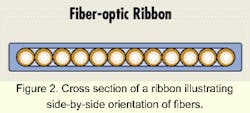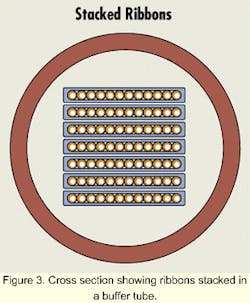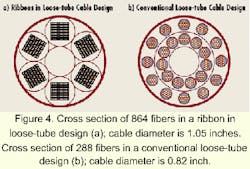Carriers learn the benefits of high-fiber-count ribbon cable
Alden Gold
Pirelli Cables and Systems of North America
Demand for network bandwidth is fueling rapid growth in ribbon-cable deployment, as carriers increasingly install high-fiber-count cables using ribbon technology to achieve the greatest packing density possible. Today's capacity demand is primarily the result of a phenomenal increase in Internet activity, driven by rapid implementation of high-data-rate e-business applications, faster computers, and relatively low Internet access costs. The demand for larger pipes shows no sign of slowing down, however. A trend toward market convergence has spawned a plethora of mergers and takeovers among service providers in an effort to eventually offer end users "one-stop shopping" for cable television, telephone, and Internet services.
Several options are available to carriers to address the demand for greater network capacity. Options include transmitting more data per fiber using dense wavelength-division multiplexing (DWDM) technology or increasing bit rates. Another is to install more fiber. Many carriers will adopt some combination of both.
The decision regarding which solution to implement largely depends on the market and capital position of the carrier. As the long-haul market matures, many DWDM vendors are looking for opportunities in the metro markets where today the majority of the increased bandwidth is needed. But only a few local service providers-primarily competitive local-exchange carriers-have aggressively pursued the implementation of DWDM in "greenfield" networks. Other carriers have been more hesitant to use this relatively new technology in their established networks, in part because of the costs involved. Thes same holds true for increasing bit rates.
If DWDM or increased bit rates are not an option, the only alternative is to deploy more fiber. Many carriers are deploying as much as twice the fiber currently needed. It is not uncommon to see carriers leveraging rights-of-way to install miles of dark (unused) fiber with the intention of leasing it in anticipation of future demand.The side-by-side orientation of the fibers provides a third advantage in that it allows mass fusion splicing. This capability to splice more than one fiber simultaneously represents tremendous savings in time and labor costs. Recent technology advances resulting in improvements in mass fusion-splicing capabilities and ribbon geometry have lowered splice losses, making ribbon an even more attractive option.
Ribbon technology also offers better fiber management and handling capabilities for cable installers. Attempting to accurately identify hundreds of fibers in one enclosure can be extremely tedious. Ribbon-in-loose-tube (RILT) cables help the installer manage this task effectively. Since the base unit of fiber grouping is still 12, there is no problem incorporating ribbon cables into existing fiber networks that use loose-tube cables.
From a technical design perspective, the capability to make cables with fiber counts well into the thousands exists today. Pirelli announced the completed development of a 1,152-fiber RILT cable in April. It's essentially only a matter of stranding more or larger buffer tubes.
As fiber counts increase, the overall size of the cable will eventually have to be larger, as well, and the industry will again face the size limitations of the existing ductwork. If there is a limit on high-fiber-count ribbon-cable development, the issue will be compatibility between the cable size with the extensive system of ductwork already in place. Ribbon-cable technology over the past two to three years has moved rapidly toward the maximum fiber count (864) that can be placed in existing 1- to 1.25-inch duct systems.
As for larger cables, the challenge for the industry is to develop the right strategy for deploying this next generation of ultra-high-fiber-count ribbon cables. Those carriers with primarily greenfield projects will need network designs with the maximum flexibility to deploy larger cables in the future. Options such as the use of larger ducts, single-cable ducts, or no inner ducts will help to maximize the potential for future growth, especially in space-constrained urban areas.
But size and space limitations are not the only considerations when pursuing the larger cable option. The development of installation equipment capable of handling larger cables and a commitment to further improvements in mass fusion-splicing equipment will also be beneficial. No doubt, these areas will be the frontline issues in the months to come.
Regardless of the issues that arise, as long the global demand for bandwidth continues to skyrocket, the strategy of many carriers for the foreseeable future is to employ whatever means necessary to continue deploying the highest fiber-count ribbon cables possible.
Alden Gold is a product manager at Pirelli Cables and Systems of North America (Lexington, SC). For more information on ribbon cable, visit the company's Website at www.na.pirelli.com.




